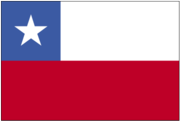Flag of Chile
|
|
The flag of Chile consists of two equal horizontal bands of white (top) and red; there is a blue square the same height as the white band at the hoist-side end of the white band; the square bears a white five-pointed star in the center representing a guide to progress and honor; blue symbolizes the sky, white is for the snow-covered Andes, and red stands for the blood spilled to achieve independence. According to the CIA World Factbook the design was influenced by the flag of the United States.
| Contents |
First Chilean flag
Chile_Patria_Vieja_flag.png
During Chile's struggle for independence, the government of José Miguel Carrera called for the creation of a national flag, the first one for the country.
On July 4 1812 the flag was raised for the first time during a banquet celebrating the independence of the United States (this event having a great influence on the locals' struggle for independence). The banquet was held by the United States Consul, Joel Robert Poinsett. A little time after, on September 30 of that same year, the seal and flag of the Old Country ("Patria Vieja") were adopted.
The banner represented the three powers of the State: Majesty, Law, and Strength. Nevertheless, this flag didn't survive the Old Country ("Patria Vieja") and in May of 1814 upon the signing of the Treaty of Lircay, Colonel Francisco de la Lastra, enemy of Carrera, commanded that the flag be taken down and replaced by the Spanish flag.
It was last used in the battle of Rancagua, October 1-2 1814, that started the Reconquest ("Reconquista"). During this period, Chile didn't have a flag. The Liberator Army ("El Ejército Libertador"), organized in Argentina, fought at the battle of Chacabuco under the sister nation's flag.
This episode, happening on the February 12 1817, signified the end of the realist control and the beginning of the New Country ("La Patria Nueva"). Afterwards the Spanish flag was no longer used.
Second Chilean flag
Chile_Transicion_flag.png
After the triumph of Chacabuco, on October 18 1817, a new banner was adopted called the "Flag of the Transition" ("Bandera de la Transición"). This flag had three stripes: blue, white, and red. The red replaced the yellow from the flag of 1812. Its design is attributed to Juan Gregorio Las Heras. These colors had their origin in the verses of Alonso de Ercilla that say: "por los pechos, al sesgo, atravesadas, bandas azules, blancas y encargadas," attributed to the warrior traits of the Mapuches during the Conquest ("la Conquista").
The red symbolized the heroes' blood shed on the field of battle; the white, the snow of the Andes range; and the blue, the clean Chilean sky.
As with the Old Country's (La Patria Vieja's) flag, this flag was never official and soon disappeared. Among other reasons, it was easily confused with the flag of the Netherlands.
Third and current Chilean flag
Today's Chile flag was conceived by Bernardo O'Higgins's Minister of War José Ignacio Zenteno and designed by Antonio Arcos, although some afirm that is was Gregorio de Andía y Varela who drew it.
This model, made official on October 18, 1817, was used during the oath of Independence.
In 1854 the proportion of each flag color was set and in 1912 the star diameter was established.
How to display the Chilean flag
ChileanFlagWaving.jpg
According to Chilean law, citizens are required to display the flag on certain national holidays including independence day (September 18). If Chileans display the flag incorrectly, they can be fined by the police.
On a Pole
The flag pole must be white and the flag must hang from the top of the pole. If the Chile flag is displayed with those of other countries, they should all be of equal size and raised to the same height. Also in this case, the flag should be raised first and lowered last.
Freely Hanging
The Chile flag can be displayed hanging either vertically or horizontally from a building or wall. In both cases, the blue square should be to the viewer's upper left.
Trivia
The Chilean flag is similar to the flag of the U.S. state of Texas.
| National flags |
| List of national flags | List of national coats of arms |
External link
es:Bandera de Chile fr:Drapeau du Chili it:Bandiera cilena he:דגל צ'ילה pl:Flaga Chile pt:Bandeira do Chile sv:Chiles flagga


